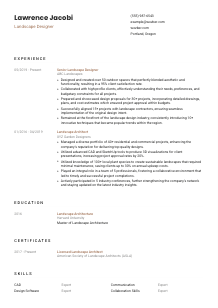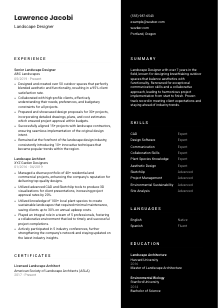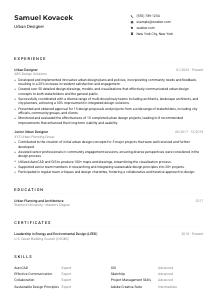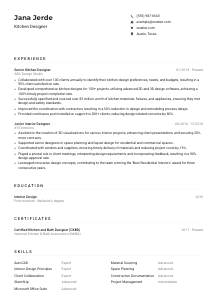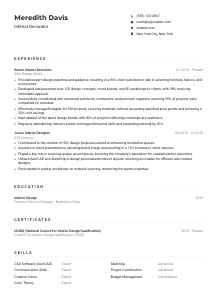Landscape Designer Resume Example
Transforming outdoor spaces, but your resume feels a little weedy? Dig into this Landscape Designer resume example, shaped using Wozber free resume builder. Discover how you can effortlessly cultivate your design talents to align with job horizons, growing your career as beautifully as a well-landscaped garden!

How to write a Landscape Designer Resume?
Hello there, Landscape Designer in the making! If you're passionate about creating beautiful and sustainable outdoor spaces and want to turn this passion into your next career move, crafting an impeccable resume is your stepping stone. Understandably, navigating through the myriad demands of job descriptions and aligning your resume perfectly might seem daunting.
However, fear not! Using the Wozber free resume builder, this article will guide you through tailoring your resume, ensuring it's not just a document but a narrative of your professional saga, ready to captivate your future employer.
Personal Details
First impressions count, and in the world of job applications, your Personal Details section is exactly that. To make a splash as a Landscape Designer, let's ensure this section draws the right kind of attention and sets you up for success.
1. Brand Yourself with Your Name
Your name is more than just a label; it's the headline of your professional story. Make sure it's visible at a glance by using a clear, professional font. This isn't the place for decorative scripts; you want your name to be memorable for its impact, not its curls.
2. Job Title Precision
Immediately below your name, articulate the position you're aspiring for. Since you're targeting a "Landscape Designer" role, that's exactly how you should brand yourself. This aligns your application with the job from the get-go.
3. Essential Contact Details
Here, clarity and professionalism are key. Include your phone number and a professional email address (think first.last@example.com). Triple-check for typos – an error here could mean a missed opportunity.
4. Location Matters
"Must be located in Portland, Oregon" – since the job description emphasizes this, highlighting your Portland, Oregon, residency upfront matches you to a T with this requirement, smoothing out any concerns about relocation.
5. Digital Presence
If applicable, adding a professional LinkedIn profile or personal website related to landscape design can provide a deeper insight into your accomplishments and projects, making your application stand out.
Takeaway
Crafting the Personal Details section is akin to laying the first stone of your professional portrait. It sets the tone for your resume, ensuring everything from your name to your digital presence is polished and professional, reflecting your suitability for the Landscape Designer role right from the start. Let this section speak volumes about your professionalism and attention to detail.





Experience
The Experience section of your resume is your professional battleground, where each bullet point fortifies your candidacy. Let's strategically sculpt this landscape to reflect your prowess in the realm of landscape design.
- Designed and created over 50 outdoor spaces that perfectly blended aesthetic and functionality, resulting in a 95% client satisfaction rate.
- Collaborated with high‑profile clients, effectively understanding their needs, preferences, and budgetary constraints for all projects.
- Prepared and showcased design proposals for 30+ projects, incorporating detailed drawings, plans, and cost estimates which ensured project approval within budgets.
- Successfully aligned 15+ projects with landscape contractors, ensuring seamless implementation of the original design intent.
- Remained at the forefront of the landscape design industry, consistently introducing 10+ innovative techniques that became popular trends within the region.
- Managed a diverse portfolio of 40+ residential and commercial projects, enhancing the company's reputation for delivering top‑quality designs.
- Utilized advanced CAD and SketchUp tools to produce 3D visualizations for client presentations, increasing project approval rates by 20%.
- Utilized knowledge of 100+ local plant species to create sustainable landscapes that required minimal maintenance, saving clients up to 30% on annual upkeep costs.
- Played an integral role in a team of 5 professionals, fostering a collaborative environment that led to timely and successful project completions.
- Actively participated in 5 industry conferences, further strengthening the company's network and staying updated on the latest industry insights.
1. Analyze the Job Description
Dissecting the job description is your first step. Identify core responsibilities and required skills, like proficiency in CAD and SketchUp, understanding local plant species, and effective communication. This will form the foundation of your tailored experience section.
2. Map Out Roles and Achievements
Structure your experience with your latest role at the forefront. From overseeing 50 outdoor spaces to ensuring project alignment with design intent, every listed accomplishment should reflect a direct response to the job description's demands.
3. Detail Your Design Successes
Highlight specific projects where your design vision came to life – mentioning the utilization of CAD and SketchUp, the types of spaces you've designed, and any innovative techniques you've introduced. This vividly demonstrates your technical expertise and creative flair.
4. Quantify Your Impact
Numbers stand out. Whether it's a client satisfaction rate or the number of projects led, quantifying your achievements makes your contributions palpable, offering a clear measure of your value and effectiveness.
5. Relevance is Key
Stay laser-focused on experiences that underscore your landscape design prowess. Each point should weave into the narrative that you're the ideal candidate for this Landscape Designer role, equipped with both the creative vision and technical skill the position demands.
Takeaway
The Experience section is your professional showcase, narrating your journey through the landscape design world. It's the core of your resume where each project, skill, and achievement is a testament to your fit for the role. Thoughtfully crafting this section ensures it echoes the job requirements, positioning you as the ideal candidate. Remember, it's about quality, relevance, and impact.
Education
Education lays the groundwork for your professional journey. In the realm of Landscape Design, formal education signals your foundational knowledge and technical competencies. Let's ensure this section does justice to your academic achievements and aligns perfectly with your career goals.
1. Highlight Requisite Degrees
The job seeks candidates with a Bachelor's degree in Landscape Architecture or a related field. Make sure your highest relevant degree is prominently featured, directly linking your academic background with the job's educational requirements.
2. Structure for Clarity
Organize your educational background concisely. Include your degree and field of study, followed by the name of the institution and your graduation year. This straightforward format ensures your qualifications are easily digestible at a glance.
3. Tailor Degree Details
If your degree directly aligns with Landscape Architecture, give it the spotlight. For broader degrees, consider specifying coursework or projects that directly pertain to landscape design, highlighting your targeted educational path.
4. Coursework That Counts
For newer entrants to the field, detailing relevant coursework or studio projects can further underline your passion and competency in landscape design, offering an additional layer of relevance to your academic credentials.
5. Additional Academic Achievements
While your degree takes center stage, don't shy away from mentioning honors, relevant extracurricular activities, or memberships in professional associations like ASLA, provided they add value to your role as a Landscape Designer.
Takeaway
Your education is more than just a list of degrees; it reflects your foundational expertise and dedication to your craft. Tailoring this section to resonate with the role's requirements showcases your readiness to thrive as a Landscape Designer. Remember, every detail counts, turning your academic journey into an integral chapter of your professional story.
Certificates
In the ever-evolving landscape of Landscape Design, staying abreast with certifications can significantly bolster your resume. While the job description might not specify them, possessing relevant certifications showcases your commitment to your craft and ongoing professional development.
1. Survey Relevant Certifications
Start by understanding the landscape - no pun intended. While our specific job description doesn't demand certifications, having them could set you apart. Look for those recognized by the industry, such as the Licensed Landscape Architect by ASLA or Certified Arborist by ISA.
2. Choose Quality Over Quantity
It's tempting to list every certificate you've ever earned, but focus on those most relevant to landscape design. This ensures the hiring manager immediately sees the certifications that testify to your expertise and dedication to the field.
3. Be Current
Especially for licenses and certifications with expiry dates, make sure to include the validity period. This transparency shows your certifications are current, reflecting your up-to-date knowledge and compliance with industry standards.
4. Continuous Learning
The landscape design field is dynamic, with new trends and technologies constantly emerging. Highlighting recent certifications demonstrates your initiative to keep learning and growing professionally, an attractive trait for potential employers.
Takeaway
Certifications are the badges of your continued professional growth and specialization. By strategically showcasing relevant certifications, you're not just ticking boxes but painting a picture of your dedication to staying at the forefront of Landscape Design. Remember, in a field as competitive and dynamic as this, every certificate you choose to display adds a layer of depth to your professional narrative.
Skills
The Skills section is your professional toolbox – a concise display of the technical and soft skills that make you the ideal candidate for the Landscape Designer role. In a field where creativity meets technicality, let's ensure your skills translate your readiness and versatility.
1. Dissect Job Requirements
First off, extract the skills directly mentioned in the job description. For a Landscape Designer, this includes proficiency in CAD and SketchUp, a strong understanding of local plant species, and stellar communication and collaboration abilities.
2. Core Skills Alignment
Mirror the job requirements with your skillset. Place your expertise in design software, plant species knowledge, and communication prowess upfront. This custom-tailored approach signals your capabilities are in direct sync with the role's demands.
3. Precision Selection
Rather than listing every skill you possess, focus on those most relevant to landscape design. This brevity ensures the hiring manager's attention is drawn to your most pertinent, role-specific talents, reinforcing your suitability for the position.
Takeaway
The Skills section is your opportunity to showcase the professional toolkit you bring to the Landscape Designer role. By highlighting the skills that directly address the job requirements, you're affirming your suitability and readiness for the role. Remember, it's not about the quantity of skills but the relevance and quality that set you apart.
Languages
Being multilingual in the field of Landscape Design can offer a unique advantage, especially when working in diverse communities or international contexts. Let's navigate how to effectively showcase your linguistic skills to further embellish your resume.
1. Job Description Review
"Effective use of the English language is essential" – this specific requirement hints at the importance of clear communication. Start by emphasizing your proficiency in English, categorizing it rightly as 'Native' or 'Fluent'.
2. Prioritize Pertinent Languages
Highlight your mastery of English first, given its explicit mention in the job requirements. But don't stop there - if you speak other languages, include them as well to demonstrate your versatility and ability to engage with diverse client bases.
3. Honest Proficiency Levels
Be truthful about your level of fluency. Misrepresenting your language abilities can lead to awkward situations, particularly if the role involves client interactions or presentations in those languages.
4. Assess Role's Scope
Think about the role's demands and opportunities. If you envision working on projects with a broader, possibly international demographic, your multilingual skills could be a strong selling point, adding depth to your application.
5. Global Market Perspectives
Understanding and speaking multiple languages opens doors to global market insights and trends in landscape design, offering you a broader perspective that can enrich your work and appeal to prospective employers.
Takeaway
Your linguistic skills are a reflection of your adaptability and potential to connect in a multicultural professional landscape. In a field as client-oriented and creative as Landscape Design, these skills can differentiate you, showcasing a global perspective and an ability to cater to diverse client needs. Embrace and display your language skills, as they enhance your professional narrative and your appeal to potential employers.
Summary
Your resume's Summary is the garden gate that welcomes potential employers into your professional landscape. A well-crafted Summary can intrigue and persuade, setting the stage for the detailed accomplishments and skills that follow. Let's ensure yours is as inviting and informative as a perfectly designed garden.
1. Core Essence
Begin by absorbing the essence of what makes a stellar Landscape Designer. Reflect this understanding in your introduction by stating your experience length and your undeniable passion for crafting sustainable and aesthetically pleasing outdoor spaces.
2. Reflect Job Requirements
Weave in your specific skills and achievements that directly respond to the job description. Mention your proficiency in CAD and SketchUp, your project management successes, and your ability to stay abreast of landscaping trends.
3. Concise Power
Aim for a punchy, powerful summary that encapsulates your qualifications, skills, and what you bring to the table. Think of it as your professional highlight reel, distilled into 3-5 compelling sentences.
4. Personal Flair
Don't be afraid to let a bit of your personality shine through. Landscape Design is as much about creativity as it is about technical skill; showing a hint of your personal flair can make your Summary—and your entire resume—memorable.
Takeaway
The Summary section is your chance to captivate and compel right from the start. By artfully crafting a brief narrative that resonates with the Landscape Designer role, you're laying out the welcome mat to your professional world, inviting hiring managers to step inside. Make those first sentences count, presenting a crisp, vivid snapshot of your professional ethos, achievements, and the unique perspectives you offer. Your resume is your professional portrait; ensure it's a masterpiece that no employer can overlook.
Launching Your Landscape Designer Journey
Congratulations on reaching the culmination of this guide. With every section crafted and aligned to the nuances of the Landscape Designer role, your resume is now not just a document, but a testament to your passion, expertise, and readiness for the role. Utilize the Wozber free resume builder, along with its ATS-friendly resume templates and ATS resume scanner, to ensure your resume not only meets but surpasses ATS optimization and hiring manager expectations. Your landscape design story is unique, and it's time to share it with the world.
Go ahead, nurture your career aspirations as thoughtfully as you would a garden. The path is laid out; your next big opportunity is just over the horizon. Embrace it with confidence.

- Bachelor's degree in Landscape Architecture or related field.
- Minimum of 3 years experience in landscape design or a related role.
- Proficiency in CAD, SketchUp, and other design software.
- Strong understanding of local plant species, their growth patterns, and soil types.
- Excellent communication and collaboration skills.
- Effective use of the English language is essential.
- Must be located in Portland, Oregon.
- Design and create outdoor spaces that are aesthetic, functional, and environmentally friendly.
- Work closely with clients to understand their needs, preferences, and budgetary constraints.
- Prepare and present design proposals, including detailed drawings, plans, and cost estimates.
- Collaborate with landscape contractors and ensure project implementation aligns with original design intent.
- Stay updated on the latest trends, techniques, and regulations in the landscape design industry.





